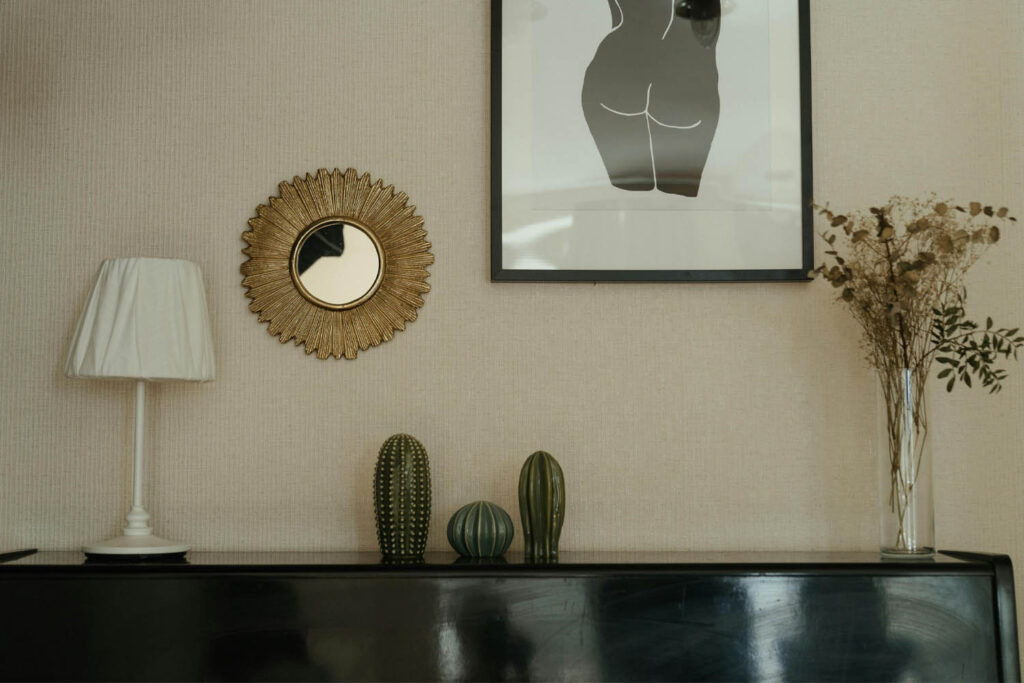Finding common ground when it comes to interior design can be a challenge for couples with differing preferences. However, with open communication, compromise, and a dash of creativity, it’s possible to create a space that reflects both of your personalities harmoniously.
In this guide, we’ll explore some practical styling tips for couples navigating conflicting tastes in home decor.

Start with Visualization
Begin by creating a shared space where you both can compile visuals of your design preferences. This could be a physical mood board or a digital platform where you can pin images of furniture, color schemes, and decorative elements that appeal to you. By visually articulating your preferences, you’ll gain a better understanding of each other’s tastes and identify potential areas of overlap.
Seek Common Ground
Once you’ve gathered your visual inspirations, take the time to discuss them together. Highlight elements that resonate with both of you and identify themes or styles that you both appreciate. Whether it’s a preference for modern minimalism or cozy rustic charm, finding common ground will lay the foundation for a cohesive design plan.
Embrace Color
Color can be a contentious issue in interior design, especially for couples with conflicting tastes. Instead of dismissing each other’s color preferences outright, consider exploring the reasons behind them. Perhaps one partner gravitates towards soothing neutrals for a sense of calm, while the other prefers vibrant hues for energy and vitality.
By understanding the motivations behind your color choices, you can find creative ways to incorporate them into your home in a balanced manner.
Practice Compromise
Inevitably, there will be areas where your tastes diverge significantly. This is where compromise becomes essential. Rather than insisting on having everything your way, be open to negotiation and willing to meet halfway.
For example, if one partner loves bold patterns while the other prefers simplicity, consider incorporating subtle hints of pattern through accessories or accent pieces.
Focus on Functionality
Beyond aesthetics, prioritize functionality in your design decisions. Identify the needs and preferences of each partner, whether it’s ample storage space, comfortable seating, or designated work areas. By ensuring that your home meets the practical requirements of both individuals, you can create a space that enhances daily living for everyone involved.
Keep reading for invaluable styling tips tailored for couples navigating conflicting tastes, ensuring harmony and cohesion in your shared space while honoring each individual’s preferences and personality.
Blend Styles Seamlessly
Don’t feel constrained by rigid design categories. Instead, embrace the opportunity to blend styles and textures in innovative ways. Mix traditional and contemporary elements, experiment with contrasting materials, and layer different patterns to add depth and visual interest to your space. By embracing eclecticism, you can create a home that feels uniquely yours.
Respect Each Other’s Sentiments
Above all, respect each other’s sentiments and preferences throughout the design process. If there’s an element that one partner particularly dislikes, take the time to understand the reasons behind their aversion and explore alternative solutions together.
Remember that compromise doesn’t mean sacrificing your individuality but rather finding creative solutions that reflect both of your personalities.
Create Zones for Personal Expression
Allocate designated zones within your home where each partner can express their individual tastes freely. Whether it’s a cozy reading nook adorned with vintage treasures or a home office adorned with sleek modern furniture, these personalized spaces can serve as creative sanctuaries where each partner can retreat and feel truly at home.

Incorporate Sentimental Touches
Infuse your home with sentimental touches that hold meaning for both partners. Whether it’s displaying cherished photographs, incorporating heirloom pieces passed down through generations, or showcasing souvenirs from memorable travels, these personal mementos can add warmth and personality to your space while bridging the gap between conflicting tastes.
Experiment with Temporary Solutions
If you’re hesitant to commit to permanent design decisions, consider experimenting with temporary solutions such as removable wallpaper, peel-and-stick tiles, or interchangeable artwork. These versatile options allow you to test out different styles and aesthetics without the fear of long-term commitment, providing a low-risk way to explore and compromise on design preferences.
Seek Professional Guidance
Sometimes, navigating conflicting tastes may require the expertise of a professional interior designer. A skilled designer can act as a mediator, helping couples identify areas of compromise, offering creative solutions, and translating their vision into a cohesive design plan. With their guidance, you can navigate the complexities of conflicting tastes with confidence and achieve a result that exceeds both of your expectations.
Celebrate Your Unique Blend
Ultimately, remember that the beauty of your home lies in its ability to reflect the unique blend of personalities, tastes, and experiences of both partners. Rather than striving for perfection or uniformity, celebrate the diversity of your styles and embrace the eclectic mix that makes your home truly one-of-a-kind. By embracing your differences and working together, you can create a space that not only looks beautiful but also feels authentically yours.
Navigating conflicting tastes in interior design can be challenging, but with patience, communication, and a willingness to compromise, couples can create a home that reflects their unique blend of styles harmoniously. By starting with visualization, seeking common ground, and embracing creativity, you can transform your space into a sanctuary where both partners feel comfortable and at ease.
So, roll up your sleeves, unleash your creativity, and embark on this exciting journey of styling your home together.











